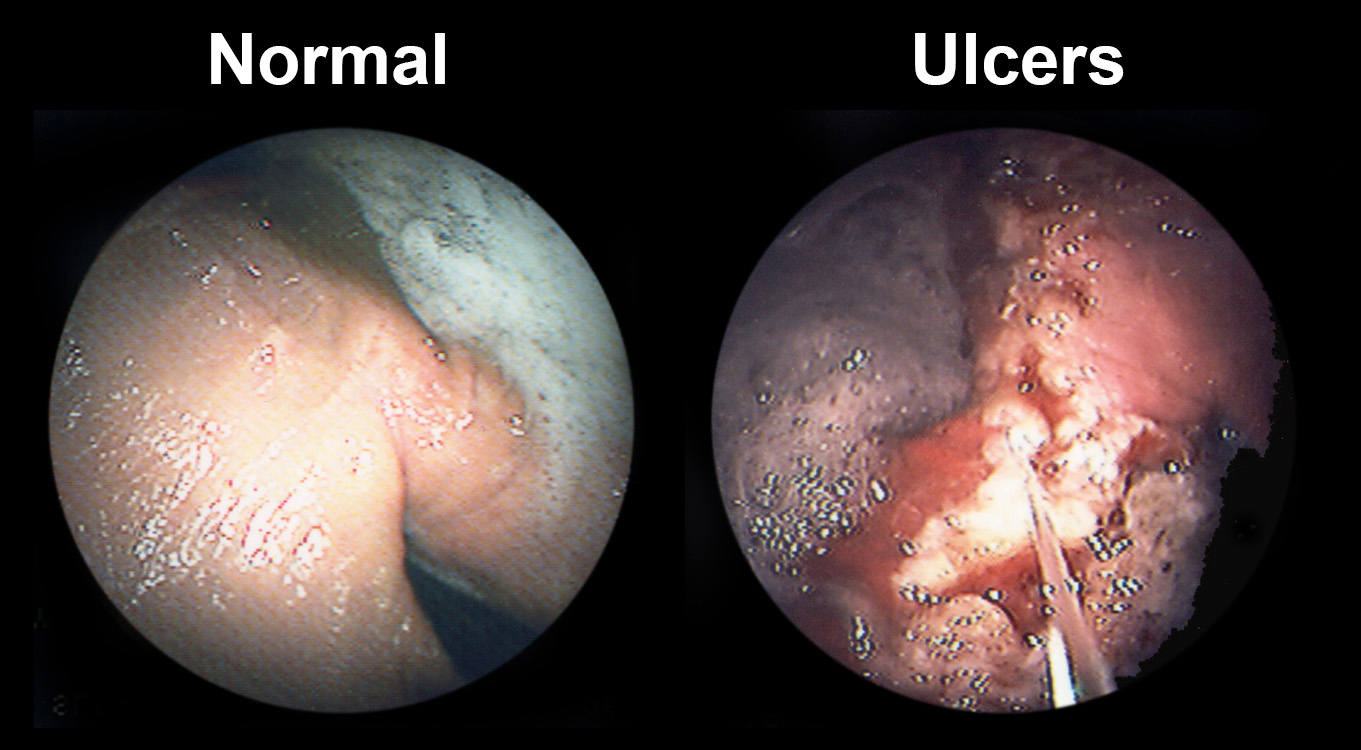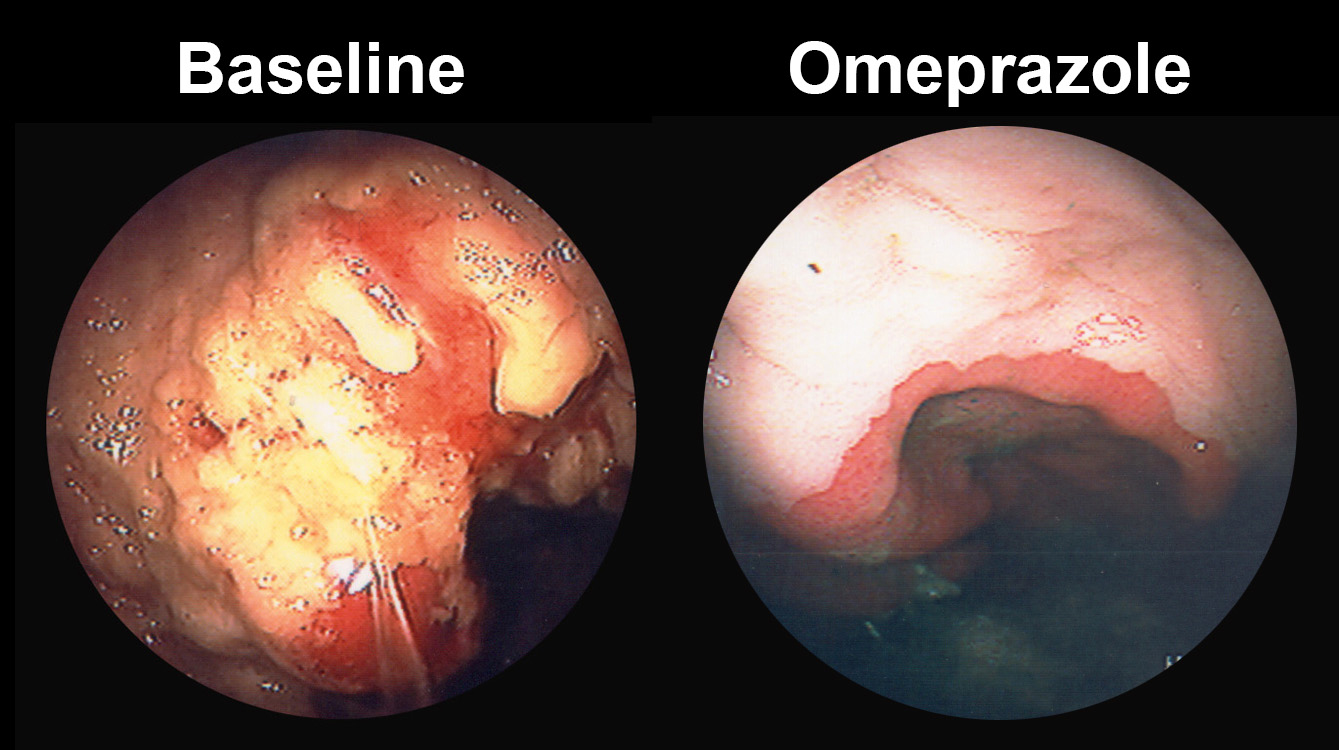
Equine Gastric Ulcer Syndrome
What are gastric ulcers?
Takeaways
- Gastric ulcers in horses are common and clinical signs may be subtle.
- Treatment should include management modifications.
- Preventative treatment may be a good option for performance horses that are going to be transported or stabled in a new environment.
Gastric, or stomach, ulcers are sores that form on the stomach lining. They are common in horses, with the prevalence estimated between 50 and 90%. They can affect any horse at any age but occur most frequently in horses that perform athletic activities such as racing, endurance, and showing. Researchers have found that exercise increases gastric acid production and decreases blood flow to the GI tract. In addition, when horses exercise, the acidic fluid in the stomach splashes and exposes the upper, more vulnerable portion of the stomach to an acidic pH.
The stomach of the horse is relatively smaller in comparison to other species. As a result, horses cannot handle large amounts of food; they are built to graze and eat frequent, small portions of feed for extended periods. In a natural grazing situation, a steady flow of acid is required for digestion, so a horse’s stomach produces acid 24 hours a day, 7 days a week – up to 9 gallons of acidic fluid per day, even when not eating. In a natural, high-roughage diet, the acid is buffered by both feed and saliva. When horses are fed two times per day, which is common in many boarding situations, the stomach is subjected to a prolonged period without feed to neutralize the acid. In addition, high-grain diets produce volatile fatty acids that can also contribute to the development of ulcers. Physical and environmental stressors such as transport stress and stall confinement are additional risk factors. Lastly, chronic administration of some nonsteroidal anti-inflammatory drugs (NSAIDs) such as phenylbutazone (“bute”), flunixin meglumine (banamine) or ketoprofen can decrease the production of the protective mucus layer of the stomach, making it more susceptible to ulcers.
What are the clinical signs of gastric ulcers?
The majority of horses with gastric ulcers do not show outward clinical signs and can appear completely healthy. Subtle signs may include:
- Poor appetite
- Dullness
- Attitude changes
- Decreased performance
- Reluctance to train
- Poor body condition
- Poor hair coat
- Weight loss
- Low grade colic
- Girthiness
More serious cases will show abdominal pain (colic) and/or grinding of the teeth. Some horses are found on their backs (especially common with foals) since this position seems to provide some relief from severe gastric ulceration. Others will walk away from food if they experience discomfort when the food first reaches the stomach.
Clinical signs of ulcers in foals include intermittent colic (after suckling or eating), frequent recumbency, reduced nursing, diarrhea, poor appetite, a pot-bellied appearance, grinding of teeth, and excess salivation. When a foal exhibits clinical signs, the ulcers are likely to be severe and should be diagnosed and treated immediately.
How are gastric ulcers diagnosed?
Gastric ulcers can only be diagnosed definitively through gastric endoscopy, or gastroscopy, which involves placing an endoscope into the stomach and looking at its surface. This procedure is easy to perform, is minimally invasive, and allows for the evaluation of the esophagus, stomach, and small intestine. A tentative diagnosis can be made based on clinical signs and how the horse responds to therapy.

How are gastric ulcers treated?
There is currently only one pharmaceutical treatment – omeprazole – approved by the U.S. Food and Drug Administration (FDA) for gastric ulcers in horses. Omeprazole is available as a paste formulation and has been very effective in preventing and treating gastric ulceration in all types of horses. Although the commercial paste is expensive, it is very effective and requires administration once a day. Due to the cost of this product, some compounding pharmacies prepare and sell paste or liquid omeprazole at cheaper prices. However, several studies have shown that the amount of active omeprazole in those products is lower than the label. In addition, the ability of those products to inhibit gastric acid production and their ability to resolve gastric ulcers has been variable. Horse owners should be wary of claims for products that are not controlled or regulated by the FDA (such as compounding products) or evaluated in scientific studies. While those products may be less expensive to purchase, they may be more costly in the end due to inefficacy.
Treatment should be initiated for horses with severe gastric ulceration, horses with clinical signs of gastric ulceration, and horses that are under stressful conditions and at risk of gastric ulceration. Under these circumstances, treatment should consist of a product labeled specifically to prevent and/or treat gastric ulcers and approved by the FDA. Treatment should be given for a full month, followed by a recheck endoscopy to confirm complete healing. The timing of when the treatment is administered is important and should be discussed with your veterinarian.
A preventative dose of omeprazole is commercially available for use around transport or stressful events. Horses with a history of gastric ulceration may benefit from proactive treatment to decrease the chances of ulcer recurrence. At this dosage, the omeprazole is less costly and may serve as a good investment.

For horses with gastric ulcers, training intensity should be reduced and turnout on pasture provided if it is available. Gastric ulcers are likely to recur if intense training is resumed. Administration of anti-inflammatory drugs and periods of fasting should be minimized as both can exacerbate lesions.
Other components of treatment commonly include inclusion of at least some alfalfa into the diet (but keeping it as <50% of the roughage in order to prevent enterolith formation), feeding a small amount of alfalfa 30 minutes prior to intense exercise, and corn oil under veterinary guidance. For severe ulcers associated with pain, sometimes a medication called sucralfate is added to the treatment regimen. Sucralfate coats the ulcers, provides symptomatic relief, and can aid ulcer healing along with omeprazole. However, sucralfate should not be administered at the same time of day as omeprazole.
What is the prognosis for gastric ulcers?
The prognosis for affected horses is generally good. Gastric ulcers can be treated and prevented relatively easily. Most heal within four weeks of treatment.
How can gastric ulcers be prevented?
The following management techniques may assist in preventing ulcers:
- Feed horses frequently or on a free choice basis (pasture). This helps to buffer the acid in the stomach and stimulate saliva production, nature’s best antacid.
- Reduce the amount of grain and concentrates and/or add alfalfa hay to the diet. Discuss any feed changes with your veterinarian so that medical conditions may be considered.
- Avoid or decrease the use of antiinflammatory drugs. If anti-inflammatory drugs must be given, use newer, safer ones such as firocoxib, if appropriate and under veterinary recommendations.
- Limit stressful situations such as intense training and frequent transporting.
- If horses must be stalled, allow them to see and socialize with other horses as well as have access to forage.
For more information:
CEH Horse Report, October 2012: http://viewer.zmags.com/publication/c532c1f9#/c532c1f9/6
*This article may not be reproduced without the written consent of the UC Davis Center for Equine Health. Please email requests to cehadmin@ucdavis.edu.
